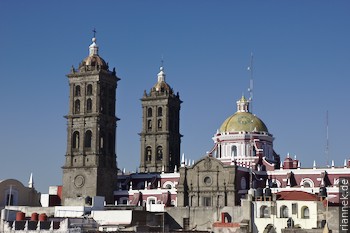
The megacity of Puebla lies to the east of the volcanoes Popocatépetl and Iztaccíhuatl, the much older town of Cholula is now more or less a western suburb. Both are worth seeing, with colonial architecture, ruins of the Cholula culture and the active volcano Popocatépetl smoking in the background (luckily the smog was kept within limits).

Unfortunately, this area was particularly hard hit by the earthquake a month ago (19.09.2017), with the spire of some churches lying next to the tower on the pavement and some palaces (including the Casa del Alfeñique with its façade overloaded with stucco curlicues) having to be shored up with a wooden or metal frame. Accordingly, many churches and museums were closed.

On the whole, however, both cities are still standing. Puebla has a completely different flair than most other colonial cities, such as Mérida, San Cristóbal, Oaxaca, Taxco or Cholula. The buildings are not so low, but several storeys high, and the façades are full of details. The city is known for having many façades (by far not all) decorated with painted tiles, azulejos.

The cathedral (Renaissance and Baroque) is impressive. The other churches are very Baroque, which I recover from in the Museo Amparo: Besides the collection with pre-Hispanic Mexican art, I see good special exhibitions with modern art and photography. And as a bonus, there’s a great view over the city from the roof terrace.
In Cholula there is the largest pyramid (by volume) ever built by man. At first glance, however, it is hardly visible; it is a hill covered with grass and trees, with a church on top. Instead of uncovering it, archaeologists have dug a tunnel system that also shows several older smaller pyramids inside. And you get to go through one tunnel! There is little to see of the stacked pyramids themselves, they were built with adobe bricks, with an outer skin of limestone and so you see mostly adobe and now and then a few limestone steps. Still, it’s a cool feeling. And on the other side is the excavated forecourt.

When the Spaniards arrived here, the pyramid was already overgrown and surrounded by a newer city of a younger culture. They raged particularly fiercely among the population and subsequently built a new town (or two, on either side of the pyramid: San Pedro de Cholula and San Andrés de Cholula) with an absurd number of churches and not one but two main squares. The Zócalo of San Pedro de Cholula is completely oversized for such a small town. However, they also soon founded “Puebla de los Angeles” nearby.

I have often seen photos of Cholula with the pyramid in front of Popocatépetl (preferably snow-covered and just erupting). Unfortunately, they are often aerial photos and I spend some time looking for a suitable location. The best I find is a wasteland next to the highway to Puebla, my subject framed between concrete and fortunately also a few trees (no snow, no eruption). Too late, a photographer tells me that there is a better place a little further on, near the university.
The best view of the mountains is from the pyramid itself. The church on top has been a construction site since the earthquake and even all the paths up were closed off. But at sunrise, no one seems to mind if you ignore the flutter tape at the back entrance; I wasn’t the only one with a camera on a tripod. And this time Popocatépetl had a nice ash eruption.
In the surroundings I visit two interesting churches. When building Santa María de Tonantzintla, the Spaniards gave the indigenous people a lot of freedom. Once, a temple to Tonantzintla, the earth goddess and goddess of mothers, stood here. It became, appropriately, Maria. And the hosts of little angels, surrounded by fruits, flowers and scrolls, probably represent the paradise of the rain god Tlaloc on second glance… Nearby stands San Francisco Acatepec with a pretty tiled façade.
Read on
From Cancun to Mexico City
Iztaccíhuatl
Mexico City and around
Oaxaca
Cairo